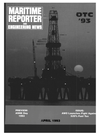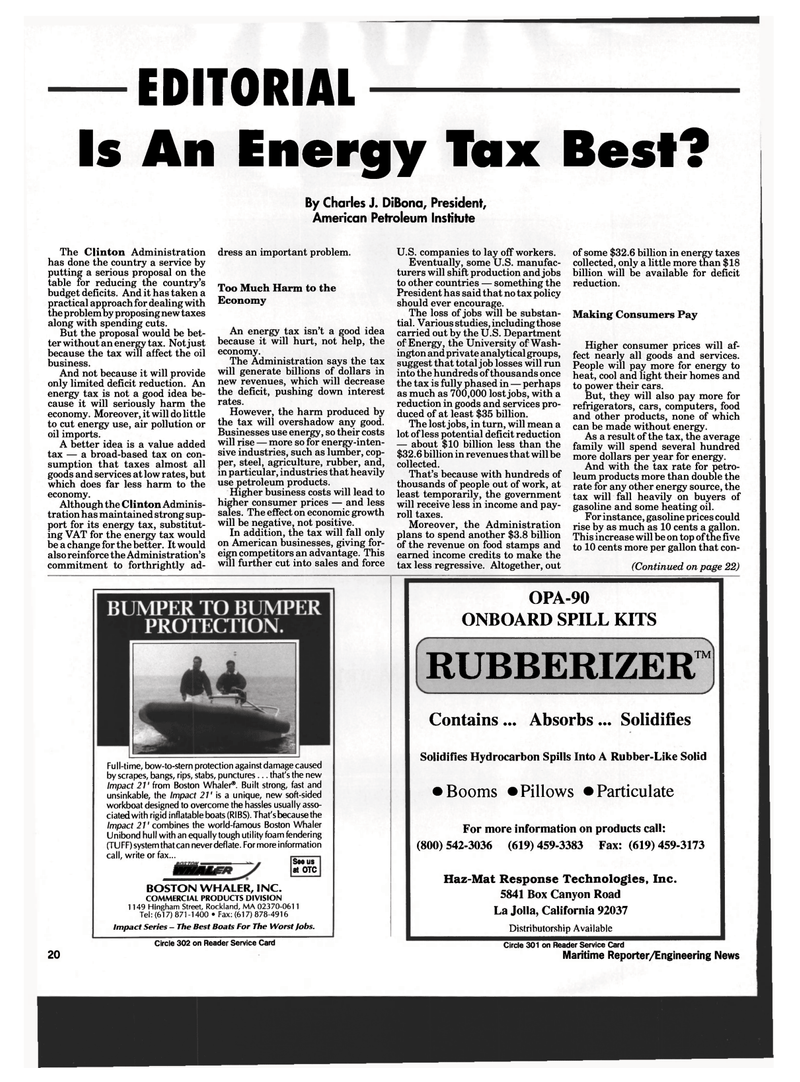
Page 18: of Maritime Reporter Magazine (April 1993)
Read this page in Pdf, Flash or Html5 edition of April 1993 Maritime Reporter Magazine
— EDITORIAL
Is An Energy Tax Best?
By Charles J. DiBona, President,
American Petroleum Institute dress an important problem.
Too Much Harm to the
Economy
The Clinton Administration has done the country a service by putting a serious proposal on the table for reducing the country's budget deficits. And it has taken a practical approach for dealing with the problem by proposing new taxes along with spending cuts.
But the proposal would be bet- ter without an energy tax. Not just because the tax will affect the oil business.
And not because it will provide only limited deficit reduction. An energy tax is not a good idea be- cause it will seriously harm the economy. Moreover, it will do little to cut energy use, air pollution or oil imports.
A better idea is a value added tax — a broad-based tax on con- sumption that taxes almost all goods and services at low rates, but which does far less harm to the economy.
Although the Clinton Adminis- tration has maintained strong sup- port for its energy tax, substitut- ing VAT for the energy tax would be a change for the better. It would also reinforce the Administration's commitment to forthrightly ad-
An energy tax isn't a good idea because it will hurt, not help, the economy.
The Administration says the tax will generate billions of dollars in new revenues, which will decrease the deficit, pushing down interest rates.
However, the harm produced by the tax will overshadow any good.
Businesses use energy, so their costs will rise — more so for energy-inten- sive industries, such as lumber, cop- per, steel, agriculture, rubber, and, in particular, industries that heavily use petroleum products.
Higher business costs will lead to higher consumer prices — and less sales. The effect on economic growth will be negative, not positive.
In addition, the tax will fall only on American businesses, giving for- eign competitors an advantage. This will further cut into sales and force
U.S. companies to lay off workers.
Eventually, some U.S. manufac- turers will shift production and jobs to other countries — something the
President has said that no tax policy should ever encourage.
The loss of jobs will be substan- tial. Various studies, including those carried out by the U.S. Department of Energy, the University of Wash- ington and private analytical groups, suggest that total job losses will run into the hundreds of thousands once the tax is fully phased in — perhaps as much as 700,000 lost jobs, with a reduction in goods and services pro- duced of at least $35 billion.
The lost jobs, in turn, will mean a lot of less potential deficit reduction — about $10 billion less than the $32.6 billion in revenues that will be collected.
That's because with hundreds of thousands of people out of work, at least temporarily, the government will receive less in income and pay- roll taxes.
Moreover, the Administration plans to spend another $3.8 billion of the revenue on food stamps and earned income credits to make the tax less regressive. Altogether, out of some $32.6 billion in energy taxes collected, only a little more than $18 billion will be available for deficit reduction.
Making Consumers Pay
Higher consumer prices will af- fect nearly all goods and services.
People will pay more for energy to heat, cool and light their homes and to power their cars.
But, they will also pay more for refrigerators, cars, computers, food and other products, none of which can be made without energy.
As a result of the tax, the average family will spend several hundred more dollars per year for energy.
And with the tax rate for petro- leum products more than double the rate for any other energy source, the tax will fall heavily on buyers of gasoline and some heating oil.
For instance, gasoline prices could rise by as much as 10 cents a gallon.
This increase will be on top of the five to 10 cents more per gallon that con- (Continued on page 22)
Full-time, bow-to-stern protection against damage caused by scrapes, bangs, rips, stabs, punctures... that's the new
Impact 21' from Boston Whaler®. Built strong, fast and unsinkable, the Impact 2V is a unique, new soft-sided workboat designed to overcome the hassles usually asso- ciated with rigid inflatable boats (RIBS). That's because the
Impact 21' combines the world-famous Boston Whaler
Unibond hull with an equally tough utility foam tendering (TU FF) system that can never deflate. For more information call, write or fax...
KHMXi
See us at OTC
BOSTON WHALER, INC.
COMMERCIAL PRODUCTS DIVISION 1149 Hingham Street, Rockland, MA 02370-0611
Tel: (617) 871-1400 • Fax: (617) 878-4916
Impact Series - The Best Boats For The Worst Jobs.
Circle 302 on Reader Sen/ice Card
OPA-90
ONBOARD SPILL KITS
TM RUBBERIZER
Contains ... Absorbs ... Solidifies
Solidifies Hydrocarbon Spills Into A Rubber-Like Solid • Booms •Pillows •Particulate
For more information on products call: (800)542-3036 (619)459-3383 Fax: (619)459-3173
Haz-Mat Response Technologies, Inc. 5841 Box Canyon Road
La Jolla, California 92037
Distributorship Available 20
Circle 301 on Reader Service Card
Maritime Reporter/Engineering News

 17
17

 19
19
